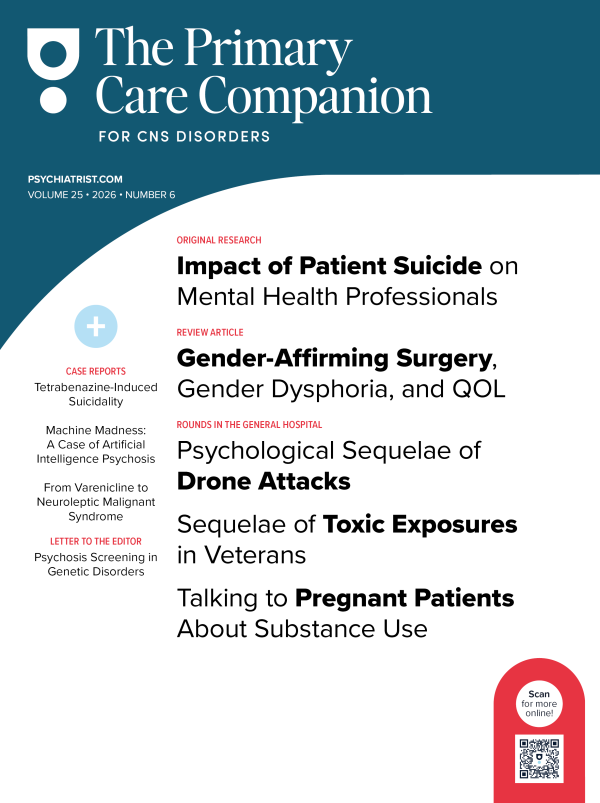Comorbid Bipolar Disorder and Usher Syndrome
To the Editor: Co-occurrence of psychiatric disorder and rare syndromes with known gene loci can facilitate critical pathophysiologic insights and might have important therapeutic implications as well.1 Usher syndrome is the most common type of deaf-blindness. It is a group of genetically distinct disorders phenotypically associated with dual sensory impairments as a result of congenital sensorineural hearing loss and progressive visual impairment from retinitis pigmentosa. Rarely, Usher syndrome may be associated with mental subnormality and infertility. Twenty-three percent of these patients have a psychiatric illness, mainly schizophrenia.1,2
Pathogenic Usher protein complex is a group of proteins that are neurosensory receptors at the outer hair cells of the inner ear and the retinal photoreceptor cells and are encoded by different genes present on the chromosomes 1, 8, and 14.3,4 Mutation of any one of the multiple genes in these chromosomes leads to the symptom complex of Usher syndrome.
Although co-occurrence of psychosis with Usher syndrome has been reported,5-7 co-occurrence of bipolar disorder has not been reported. For the first time, we report a patient with bipolar disorder and Usher syndrome and the treatment implications.
Case report. Mr A, a 25-year-old man, presented to our hospital in December 2007 with a history of elated mood, overactivity, overtalkativeness, overfamiliarity, delusions of grandiosity, decreased need for sleep, and decreased appetite for the past 3 months. In the past, Mr A had experienced 2 episodes of mania that responded to treatment with haloperidol, with complete remission of symptoms. He also had a history of congenital hearing impairment and night blindness. There was a family history suggestive of congenital deafness and night blindness in a first-degree relative. Results of investigations, namely, hemogram, liver function tests, kidney function tests, and serum electrolytes, were normal. Magnetic resonance imaging did not reveal structural abnormalities. He was evaluated using the Mini International Neuropsychiatric Inventory8 and diagnosed as having bipolar affective disorder with psychotic symptoms (ICD-10). He had a score of 16 on the Young Mania Rating Scale (YMRS).9 Audiometry showed sensorineural hearing loss for 4-8 kHz, and ophthalmic examination revealed retinitis pigmentosa, suggestive of Usher syndrome.
Mr A was started on treatment with lithium 600 mg/d for management of bipolar disorder. Subsequently, he developed hyperpigmented papular and pustular lesions involving the skin and buccal mucosa. Dermatologic opinion was sought, resulting in a diagnosis of pemphigus vulgaris, and treatment with prednisolone 30 mg/d was advised. In view of this, lithium treatment was stopped and treatment with risperidone 4 mg/d and valproate 1000 mg/d was started. He improved with this medication and at the end of 2 weeks had a score of 4 on the YMRS. Mr A had no new skin lesion, and he maintained euthymia at the end of 1 year.
To the best of our knowledge, this is the first report of the co-occurrence of Usher syndrome and bipolar disorder. Our patient had high-frequency sensory neural hearing loss and atypical retinitis pigmentosa suggestive of Usher syndrome. He developed significant side effects when lithium treatment was started. One should be cautious of dermatologic side effects when starting lithium treatment in patients with comorbid Usher syndrome. This report exemplifies the need for systematic assessment of patients with bipolar disorder in liaison with other specialties for comorbid conditions whenever indicated.
Interestingly, chromosomes 8 and 14 are also implicated in linkage studies of bipolar disorder.10 Further molecular biologic studies of such patients with comorbid bipolar disorder might facilitate better understanding of the pathogenesis of bipolar disorder.
References
1. Murphy KC, Jones LA, Owen MJ. High rates of schizophrenia in adults with velo-cardio-facial syndrome. Arch Gen Psychiatry. 1999;56(10):940-945. doi:10.1001/archpsyc.56.10.940 PubMed
2. Hallgren B. Retinitis pigmentosa combined with congenital deafness; with vestibulo-cerebellar ataxia and mental abnormality in a proportion of cases: a clinical and genetico-statistical study. Acta Psychiatr Scand Suppl. 1959;34(138):1-101. PubMed
3. Saihan Z, Webster AR, Luxon L, et al. Update on Usher syndrome. Curr Opin Neurol. 2009;22(1):19-27. doi:10.1097/WCO.0b013e3283218807 PubMed
4. Kremer H, van Wijk E, Märker T, et al. Usher syndrome: molecular links of pathogenesis, proteins and pathways. Hum Mol Genet. 2006;15(2):R262-R270. doi:10.1093/hmg/ddl205 PubMed
5. Hess-Röver J, Crichton J, Byrne K, et al. Diagnosis and treatment of a severe psychotic illness in a man with dual severe sensory impairments caused by the presence of Usher syndrome. J Intellect Disabil Res. 1999;43(pt 5):428-434. doi:10.1046/j.1365-2788.1999.043005428.x PubMed
6. Wu CY, Chiu CC. Usher syndrome with psychotic symptoms: two cases in the same family. Psychiatry Clin Neurosci. 2006;60(5):626-628. doi:10.1111/j.1440-1819.2006.01568.x PubMed
7. Jumaian A, Fergusson K. Psychosis in a patient with Usher syndrome: a case report. East Mediterr Health J. 2003;9(1-2):215-218. PubMed
8. Sheehan DV, Lecrubier Y, Sheehan KH, et al. The Mini-International Neuropsychiatric Interview (M.I.N.I.): the development and validation of a structured diagnostic psychiatric interview for DSM-IV and ICD-10. J Clin Psychiatry. 1998;59(suppl 20):22-33. PubMed
9. Young RC, Biggs JT, Ziegler VE, et al. A rating scale for mania: reliability, validity and sensitivity. Br J Psychiatry. 1978;133(5):429-435. doi:10.1192/bjp.133.5.429 PubMed
10. Segurado R, Detera-Wadleigh SD, Levinson DF, et al. Genome scan meta-analysis of schizophrenia and bipolar disorder, pt 3: bipolar disorder. Am J Hum Genet. 2003;73(1):49-62. doi:10.1086/376547 PubMed
Author affiliation: Metabolic Clinic in Psychiatry, National Institute of Mental Health & Neurosciences, Bangalore, India.
Potential conflicts of interest: None reported.
Funding/support: The authors acknowledge the National Institute of Mental Health & Neurosciences for supporting the academic investigations of this report.
Published online: March 25, 2010 (doi:10.4088/PCC.09l00792yel).
Prim Care Companion J Clin Psychiatry 2010;12(2):e1
© Copyright 2010 Physicians Postgraduate Press, Inc.


